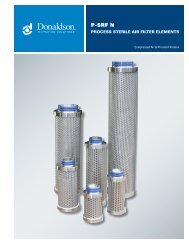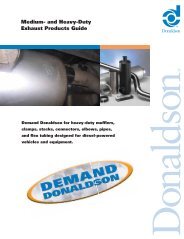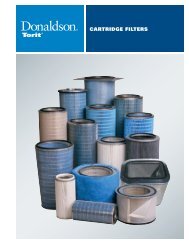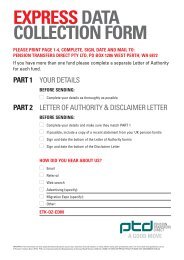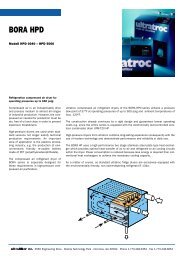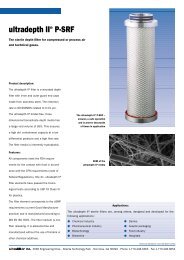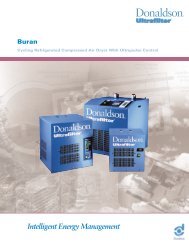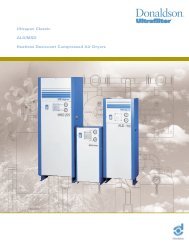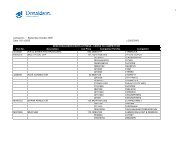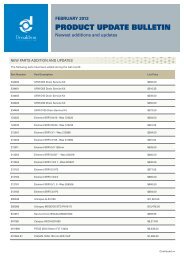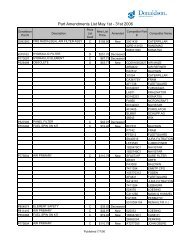HRE/HRS-L Heated Blower Purge Desiccant ... - odms.net.au
HRE/HRS-L Heated Blower Purge Desiccant ... - odms.net.au
HRE/HRS-L Heated Blower Purge Desiccant ... - odms.net.au
You also want an ePaper? Increase the reach of your titles
YUMPU automatically turns print PDFs into web optimized ePapers that Google loves.
<strong>HRE</strong>/<strong>HRS</strong>-L<strong>Heated</strong> <strong>Blower</strong> <strong>Purge</strong> <strong>Desiccant</strong> Compressed Air Dryers
HistoryUltrafilter International AG, whose world headquarters is in Haan,Germany, was established in 1972 as a trading company to buy andsell, into the German market, compressed air and gas purificationequipment. In the 1980’s, Ultrafilter established itself as a primemanufacturer of compressed air and gas dryers and filters, backed bynumerous innovative patents, and has since grown to be among thelargest such manufacturers in the world. Our product lines include, butare not limited to: air, gas and liquid filters for both process andindustrial applications; refrigerated, membrane and regenerativedesiccant compressed air and gas dryers; breathing air systems;condensate management systems; and process water chillers.In 2002, Ultrafilter was acquired by Donaldson Company, Inc.,headquartered in Minneapolis, Minnesota. Donaldson is a leadingworldwide provider of filtration systems and replacement parts.Since 1915, Donaldson has perfected and leveraged its corestrengths—innovative technology, strong customer relationships andbroad geographic presence—to meet the diverse and changing needsof its customers.The Need for Clean Dry AirThe ProblemCorrosion, erosion, product defects, line freeze-upsThe ResultEnergy savings, increased productivity, longer lasting tools, andreduced system maintenance.The C<strong>au</strong>seSolids, liquids, vapors, gasesThe SolutionHigh quality and energy efficient air and gas purification systemsAny contaminants present in the atmosphere surrounding an aircompressor will be entrained and concentrated in the process air as itenters the compressor. These contaminants can be in the form ofliquids (e.g. water and oil), vapors (e.g. hydrocarbons), gases (e.g.carbon dioxide, hydrogen chloride and sulfur dioxide) and solids (e.g.sand, dust and soot). If not removed, such contaminants can lead toserious damage of process equipment and/or degradation of the finalproduct itself through corrosion, erosion, freeze-ups, biological growthand product spoilage from contact with contaminated air. DonaldsonUltrafilter products are designed to address these problems efficientlyand economically.
Air Quality ClassificationsThe quality of compressed air you need depends a great deal on the application. The quality of compressed air you can achieve depends a greatdeal on the purification equipment selected. Refrigerated air dryers, for example, will provide air at a pressure dew point (pdp) of 38º F (ISO Class5), while regenerative desiccant air dryers are required for ISO Class 2 (-40º F) or ISO Class 1 (-94º F pdp). A number of organizations havedeveloped standards and classifications of compressed air specific to given applications. Examples include:Quality Standard for Instrument Air—American National StandardsInstitute/International Standards Association (ANSI/ISA-S7.0.01-1996)Plant Breathing Air—Compressed Gas Association (CGA, G-7.1, Grade D)Medical Air for Hospitals—National Fire Protection Agency (NFPA-99)The International Standards Organization (ISO) has established the following air quality classifications relating to maximum size andconcentration of particles, maximum pressure dew point and maximum oil content.ISO 8573-1 Air Quality ClassesClass*Max. Size(microns)ParticlesMax. Concentration(mg/m3)Max. pdp (ºF)Max. Oil Content(mg/m3)1 0.1 0.1 -94 0.012 1 1 -40 0.13 5 5 -4 14 15 8 +37.4 55 40 10 +44.6 25*Reported as ISO Class #,#,# (Particle, PDP, Oil). E.g. ISO Class 2,4,2.Externally <strong>Heated</strong> <strong>Blower</strong> <strong>Purge</strong> Compressed Air DryersAtmospheric air, heated externally, reduces purge air losses to 2% or less.While refrigerated compressed air dryers will achieve ISO Class 4 or 5 dew points, regenerative desiccant dryers are required to achieve ISO Class 1and 2 dew point levels. <strong>Desiccant</strong> dryers are generally referred to as either “heatless” or “heated.” Heatless dryers are so-named as they do notuse any source of heat for regeneration other than that given off during the drying, or adsorption, cycle. This is referred to as “the heat ofadsorption.” However, heatless dryers will consume up to 15% of the process air they are dryingduring the regeneration cycle. <strong>Heated</strong> dryers, on the other hand, utilize an externalsource of heat for regeneration and require little or no process air.Donaldson Ultrafilter <strong>HRE</strong> and <strong>HRS</strong>-L heated blower purge dryers utilizeatmospheric air for regeneration of the desiccant bed. No process air is usedduring this phase of the overall dryer cycle. Process air is only consumed duringdepressurization and repressurization of the off-line vessel and, in the case of the<strong>HRE</strong>, during cool-down of the regenerated bed. This amounts to approximately2% of the rated capacity of the dryer. The <strong>HRS</strong>-L dryer further reduces purgeair consumption by utilizing ambient air for cool-down of the regenerated bed.
<strong>HRE</strong>/<strong>HRS</strong>-L <strong>Heated</strong> <strong>Blower</strong> <strong>Purge</strong> <strong>Desiccant</strong> Compressed Air Dryers<strong>HRE</strong> and <strong>HRS</strong>-L heated desiccant compressed air dryers benefit from decades of design and fabrication experience by DonaldsonUltrafilter. Our dryers are designed to consistently provide quality air with high energy efficiency in a flow range from 600 to 5,000 scfm.Major ComponentsDESICCANTBeaded activated alumina is used as the adsorption media inheated desiccant dryers. The beads exhibit a very high internalsurface area and high moisture separation efficiency. Each lot ofdesiccant is thoroughly tested for density, moisture content,abrasion resistance, surface area, mesh size and granule strengthto assure that it meets our strict design requirements.ASME VESSELS<strong>HRE</strong> and <strong>HRS</strong>-L desiccant vessels have been designed with a widediameter for a large cross-sectional flow area. This resultsin a low flow velocity which minimizes both pressure drop acrossthe bed and attrition of the desiccant itself. The vesselsincorporate the following additional features:• Stainless steel inlet and outlet air diffusers for even flow distribution• Stainless steel bed support on units above 3,000 scfm• <strong>Desiccant</strong> fill and drain ports• 1/16" corrosion allowance• Operating pressure g<strong>au</strong>ge on each vessel• Pressure relief valve on each vesselVALVESDryer operation is controlled by acombination of butterfly, checkand globe valves, providing optimumButterfly Valvecontrol and maximum reliability atminimum cost. Butterfly valves areused at the dryer inlet and purge exh<strong>au</strong>st outlet. These valves aredesigned with a unique continuous annular raised land on thedisc that provides a sure seal around the valve stem. In addition,the butterfly valves offer these features:• High flow stainless steel disc design minimizes obstruction in flow path• Double o-ring seal at valve stem• Bronze stem bearings to eliminate stem seizures, provide reliable loadsupport and minimize torque• Hard-backed cartridge seat providing superior disc sealing integrity andeasier replacement due to slip-fit into valve body; also eliminates hightorque and premature failure c<strong>au</strong>sed by elastomer distortion found inother seat designs• Integral flange seal eliminates need for gaskets or o-rings• Position indicators• Dual-acting worm-driven actuatorsCHECK VALVESCheck valves are used at the dryer outletCheck Valveand on the hot air regeneration lines.They are designed with large ports tominimize pressure loss. Outlet checkvalves incorporate a stainless steel disc andViton ® o-rings while hot air regeneration valves utilize ametal-to-metal seal to withstand the elevated temperatures.(Viton is a registered trademark of DuPont Dow Elastomers)GLOBE VALVESAngle-seated globe valves are used to controldepressurization of the regenerating vesseland to control the dry purge air flow duringthe cooling phase of the process.Globe ValveAngle-seat globe valves offer highflow rates and long service life in compact, economical packages.BLOWERA direct drive radial-bladed centrifugal blower is used to provideambient air for themal regeneration of the off-stream bed. Theblower wheel is constructed of heavy g<strong>au</strong>ge high strength steel toassure long life and efficient operation. Wheels are dynamicallybalanced for smooth operation and the shaft is sealed with aTeflon ® seal. The blower/motor assembly is factory tested to assurelow vibration levels.HEATERAmbient air from the centrifugal blower is directed through anelectric resistance heater to elevate the temperature to 400º F forregeneration of the off-stream bed. Heaters are designed with a lowwatt density for low surface temperatures and long element life. Theheating elements are contained within tubes which are themselvesprotected with direct-contact type “K” thermocouples.ELECTRICAL CONTROLSThe entire drying/regeneration cycle is controlled by an Allen BradleyMicroLogix programmable logic controller (PLC), among the mostreliable controllers available. The PLC is supplied with an AllenBradley Microview display which, among other items, will provide theoperator with the following information:• Indicate alarm when a system f<strong>au</strong>lt is detected and identify the specific f<strong>au</strong>lt• Indicate current status of each vessel (drying, regenerating or in standby)• Indicate time remaining of each phase of the cycleGENERAL DESIGN FEATURES• Piping design and layout can have a significant impact on pressure lossthrough the entire system. <strong>HRE</strong> and <strong>HRS</strong>-L piping sections are conservativelysized to reduce system pressure loss and lower operating costs. Long radiuselbows, which reduce pressure drop to about 67% of standard elbows, areused throughout the system.• Back pressure during purge can c<strong>au</strong>se the system to consume too muchcompressed air during this phase of the cycle. To minimize this back pressure,large diameter pipe and high flow mufflers have been incorporated into the design.• Mufflers with a unique expansion chamber have been selected to allow theexh<strong>au</strong>st of purge air to atmosphere with minimal noise and free ofcontaminants. They are constructed of corrosion resistant materials, providingfor long life and low maintenance requirements.• All external surfaces are mechanically cleaned of loose particles, scale, rust,oil, grease and any other contaminant prior to painting. A primer coat isfollowed by two coats of Donaldson Ultrafilter blue for maximum protectionagainst the elements.• All components have been arranged to fit into the smallest footprint possible,saving valuable floor space.(Teflon is a registered trademark of the DuPont Company)
<strong>HRE</strong> and <strong>HRS</strong>-L Process Flow123456789Wet compressed air, controlled by butterfly valves, enters the base of the on-line vessel.As the compressed air passes through the desiccant bed, moisture is removed, lowering the dew point to -40º F.Dry compressed air exits the top of the vessel, passes through a check valve and flows downstream to the use point.When the desiccant bed becomes saturated with moisture, it goes off-line and depressurizes to ambient through an angle-seat globe valve.A muffler attenuates the noise of depressurization.After the off-line vessel has depressurized, a centrifugal blower draws in ambient air for regeneration.The ambient air is heated to 400º F, giving it the energy required to initiate and accomplish desorption, after which it passes through a checkvalve and enters the top of the regenerating vessel.As the hot ambient air passes through the desiccant bed, water molecules are released from the surface of the desiccant and enterthe air stream.Hot regeneration air passes through a butterfly valve and exits to atmosphere.At the end of the heating phase of the cycle, the desiccant bed, although regenerated, remains hot. The temperature of the bed must belowered to minimize dew point and temperature spikes in the process air when the bed goes back on-line. This is accomplished by allowing aslipstream of dry process air, controlled by an angle-seat globe valve, to flow from the on-line vessel into the off-line vessel. This slipstream isalso used to repressurize the off-line vessel after it has been cooled.a. The <strong>HRS</strong>-L heated blower purge dryer incorporates a water-cooled heat exchanger which eliminates the need for purge air duringthe cool-down period. At the end of the heat cycle, a series of valves open or close creating a closed-loop between the air blowerand vessel.b. The hot air bypasses the heater and is directed through a water-cooled heat exchanger.c. The blower circulates the cooled air back through the vessel.d. As the cooled air passes through the desiccant bed, it picks up heat energy3which is removed from the system via the water-cooled heat exchanger.The closed-loop cycle continues until the bed temperature is lowered toits operation point without the use of purge air.910Unique to the Donaldson Ultrafilter <strong>HRE</strong> is our parallel running period 10 minutesprior to vessel switchover. During this period, the incoming flow of wetcompressed air is directed through both vessels. This step further reduces oreliminates the dew point and temperature spikes associated with heateddryers while minimizing the loss of purge air used during the initial cooldown.This step is not required with <strong>HRS</strong>-L dryers.267W9aÄ9b WÅWÉ9d548WÇ9c110<strong>HRS</strong>-L Process Flow<strong>HRE</strong> Process Flow
Built-in Energy ManagementCompressed air systems do not necessarily operate at full capacity24 hours a day. When a heated dryer routinely operates at less thanits full design capacity, excess energy is consumed in the form ofunnecessary heat cycles and wasted purge air.Many adsorption dryers operate on a fixed cycle regardless ofdemand and require the addition of optional equipment to gain anybenefit from operation at less than design capacity. DonaldsonUltrafilter <strong>HRE</strong>/<strong>HRS</strong>-L dryers incorporate built-in, standard energymanagement features.Thermocouples located in the purge air exh<strong>au</strong>st and cooling air outletstreams continuously monitor the temperature of the purge for bothhigh and low set points. During the desorption phase ofregeneration, the external heater adds energy required to removeadsorbed moisture from the desiccant bed. Once desorption iscomplete, the temperature of the purge exh<strong>au</strong>st will rise as the heatenergy is no longer being consumed by the desiccant bed. This rise intemperature signals the completion of desorption and shuts downthe heater. Whenever the moisture load on the dryer is anything lessthan design capacity in a given adsorption cycle, energy is conservedand operating costs are reduced by early termination of heating.At this stage, the thermocouple in the cooling air outlet begins totrack the decrease in bed temperature during the cool-down purgecycle. At a given set point, the temperature at the cool-down purgeair outlet indicates that the bed has been lowered back down to theadsorption operating temperature. Any further reduction in bedtemperature results in wasted purge air. The cooling phase isterminated at this point.Rather than operating on fixed heating and cooling cycles, whichconsume both electrical energy and compressed air based on thedesign capacity of the dryer, these built-in energy managementfeatures reduce operating costs without the addition of specialequipment whenever the demand on the dryer is less than 100% ofits capacity.Ultraconomy Energy Management SystemAdditional savings can be achieved with the use of the optional Ultraconomy energy management system. While the built-in energymanagement features provide early termination of heating and cool-down, the dryer continues to operate on a fixed-time adsorption cycle.Switchover will occur regardless of the moisture content of the on-line bed. When operating at less than full capacity, the dryer willexperience unnecessary cycling of its valves, unnecessary compressed air losses through depressurization and repressurization cycles, andwasted heater operation.When operating in Ultraconomy mode, the dew point of the process air is monitored at thedryer outlet to determine whether or not regeneration should be initiated. The dryingstage will be extended until the dew point rises above a given set point. Only thenwill switchover to the standby vessel occur and the regeneration cycle begin,reducing wear-and-tear on the overall system and conserving electrical powerand compressed purge air.
<strong>HRE</strong>/<strong>HRS</strong>-L <strong>Heated</strong> <strong>Blower</strong> <strong>Purge</strong> <strong>Desiccant</strong> Compressed Air Dryers<strong>HRE</strong> and <strong>HRS</strong>-L dryers are designed to provide high drying efficiency in a flow range from 600 to 5,000 scfm. By utilizing an external source ofheat for regeneration, <strong>HRE</strong>/<strong>HRS</strong>-L dryers significantly reduce or eliminate the use of compressed purge air for regeneration resulting in an overallreduction in the cost of operation.Key Features and Benefits• <strong>Purge</strong> air consumption of only 2% or less• Built-in standard energy management controls• Low pressure drop design for energy savings• High quality components for reliable service and long life• Unique <strong>HRE</strong> parallel flow to reduce or eliminate dew pointand temperature spikes• Small footprint saves valuable floor space• NEMA 4 electrical enclosuresAvailable Options (partial list)• Ultraconomy energy management system• Single and dual prefilter and afterfilter systems• 3 valve bypass system• Vessel/piping insulation• Steam-based desorption system• Dew point monitor and alarm• Stainless steel instrument air tubing• Corrosion resistant finish
<strong>HRE</strong> <strong>Blower</strong> <strong>Purge</strong> <strong>Desiccant</strong> DryerDimensions (in.)Model Capacity 1 Connection (in.) <strong>Blower</strong> Installed Total Approx.Number (scfm) ANSI Flange Height Width Depth Motor HP Heater kW Average kW Weight (lbs.)0600-60 600 3 103 85 50 5.0 16.0 11.6 2,6600800-60 800 3 103 90 50 7.5 24.0 17.9 3,2601000-60 1000 3 120 95 50 7.5 27.0 19.1 3,9401200-60 1200 4 120 100 50 10.0 32.5 21.6 4,8001400-60 1400 4 115 100 55 10.0 37.0 24.4 5,2001600-60 1600 4 120 110 60 10.0 45.0 29.3 5,9002000-60 2000 4 120 115 65 10.0 52.0 33.7 7,0002400-60 2400 6 130 125 70 15.0 64.0 41.1 8,7503000-60 3000 6 130 125 70 15.0 78.0 49.9 10,6003500-60 3500 6 125 150 80 15.0 90.0 57.0 11,9004000-60 4000 6 130 155 85 20.0 100.0 63.9 13,6505000-60 5000 6 135 182 90 20.0 120.0 76.6 17,600<strong>HRS</strong>-L Zero <strong>Purge</strong> Air <strong>Blower</strong> <strong>Purge</strong> <strong>Desiccant</strong> DryerDimensions (in.)Model Capacity 1 Connection (in.) <strong>Blower</strong> Installed Total Approx.Number (scfm) ANSI Flange Height Width Depth Motor HP Heater kW Average kW Weight (lbs.)0600-60 600 3 103 118 68 5.0 16.0 12.8 4,2500800-60 800 3 103 118 68 7.5 24.0 20.0 4,8501000-60 1000 3 120 120 70 7.5 27.0 20.9 5,6401200-60 1200 4 120 124 72 10.0 32.5 22.9 6,5201400-60 1400 4 115 140 80 10.0 37.0 25.9 6,9501600-60 1600 4 120 146 83 10.0 45.0 30.9 7,7002000-60 2000 4 120 150 90 10.0 52.0 35.6 8,8002400-60 2400 6 130 180 106 15.0 64.0 43.2 10,5003000-60 3000 6 130 180 106 15.0 78.0 52.3 12,5003500-60 3500 6 125 188 112 15.0 90.0 59.4 13,8004000-60 4000 6 130 200 118 20.0 100.0 66.8 15,5005000-60 5000 6 135 225 125 20.0 120.0 80.1 19,900Capacity Correction FactorsOperating Pressure (psig)OperatingTemperature 70 80 90 100 115 130 15090° F 0.96 1.08 1.19 1.25 1.30 1.39 1.5095° F 0.77 0.91 1.06 1.16 1.30 1.39 1.50100° F 0.63 0.75 0.87 1.00 1.13 1.26 1.44105° F 0.50 0.60 0.70 0.80 0.95 1.08 1.26110° F 0.37 0.45 0.55 0.63 0.74 0.87 1.041Capacity based on -40˚ F pdp, 100 psig inlet pressure, 100˚ F inlettemperature and 100˚ F ambient according to DIN ISO 7183.Pressure dew point: -40° F standard; pdp down to -100° F available as option.Operating pressure: Minimum 70 psig; Maximum 150 psig.Operating temperature: Minimum 40° F; Maximum 110° F.Ambient temperature: Minimum 40° F; Maximum 110° F.Electrical connection 460V/3PH/60Hz.Cooling:<strong>HRE</strong> by means of dried air (average 2% of process flow).<strong>HRS</strong>-L by means of blower air in a closed loop cooling systemwith air/water heat exchanger.Installation of prefilter and afterfilter is recommended.PLC control including indicator and dry contact for common alarm.NEMA 4 control box standard.Failure-to-switch alarm standard.Regeneration cycles: standard 2 by 4 hours.Maximum fan suction condition: 95° F, 90% RH (tropical).Ordering information:Specify "Type" "Model Number"Example: "<strong>HRS</strong>-L3500-60"Donaldson Company, Inc.Ultrafilter3560 Engineering DriveNorcross, GA 30092©2004 Bulletin No. UFSB0113Toll free: 800.543.3634Telephone: 770.448.3363Telefax: 770.448.3854E-mail: ultrafilterinfo@mail.donaldson.comWeb: www.donaldson.com




